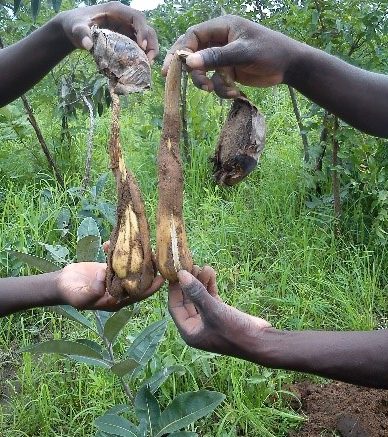Unité de Recherche en Biodiversité Informatique et Planification de la Conservation (UR-BiPlaC).
1. Contacts
Responsable de l’UR-BiPlaC: Dr Ir Gérard GOUWAKINNOU (Maître-Assistant), Tel: +229 97 34 31 89 Email: gougerano@gmail.com
Responsable Adjoint : Dr Ir Thierry HOUEHANOU (Maître-Assistant), Tel: +229 97 21 39 22 Email: houehanout@gmail.com
2. Profils des membres de l’UR
3. Présentation de l’Unité de Recherche
Thème central : Conservation et gestion durable des ressources naturelles
Préoccupation majeure de l’UR : Utiliser et/ou combiner différents domaines de sciences pour guider des prises de décision à court, moyen et long terme de la conservation et de la gestion durable de la biodiversité. Les domaines de sciences les plus concernés sont portés par les axes de recherche suivants :
Axes de recherches :
- Biodiversité et changement climatique
- Génétique de la conservation
- Ethnobotanique et services écosystémiques
- Ecologie et dynamique du paysage
- Restauration des écosystèmes
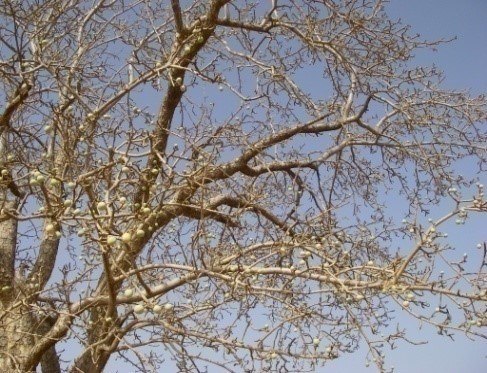
Sclerocarya birrea, en période de fructification 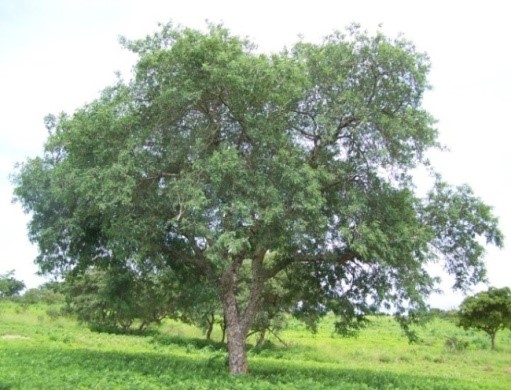
Sclerocarya birrea, en feuilles en dehors de la saison de fructification 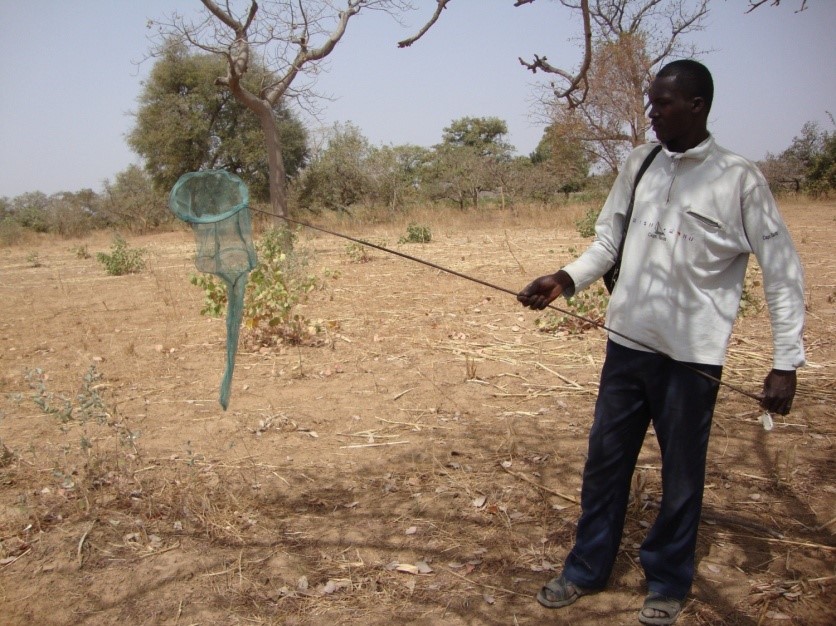
Piège utilisé pour la collecte de certains pollinisateurs 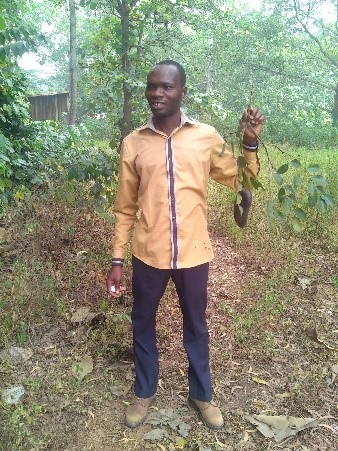
Echantillonnage des fruits de Afzelia africana pour une caractérisation morphologique 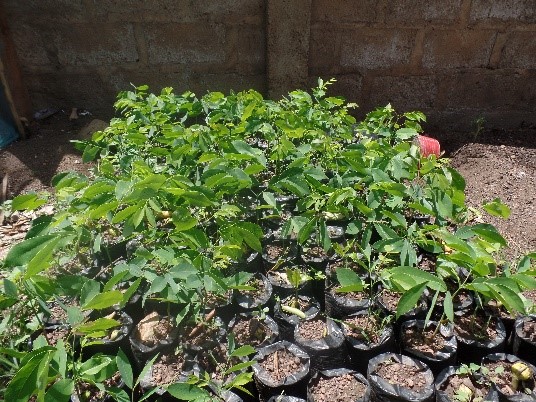
Afzelia africana plants in production
4. Projets de recherche en cours
Restauration et Gestion durable de la forêt sacrée de Tinré pour la conservation de la biodiversité et la promotion de l’écotourisme dans la commune de Parakou au Bénin
Financement : Université de Parakou, fonds compétitifs
Résumé du projet : En Afrique au Sud du Sahara, la gestion des ressources naturelles a toujours été au cœur des préoccupations de la recherche. En matière de gestion des ressources naturelles, pour atteindre les objectifs de conservation de la biodiversité, les scientifiques se sont intéressés dans ces dernières décennies aux forêts dites sacrées dont le rôle dans la conservation de la biodiversité n’est plus à démontrer. Ainsi ce projet vise à contribuer à la restauration et la gestion durable de la forêt sacrée de Tinré. Spécifiquement le projet vise à (i) Évaluer la biodiversité de la forêt sacrée de Tinrè (ii) Evaluer les représentations des populations locales sur le rôle écologique et écotouristique de la forêt sacrée de Tinré (iii) Evaluer l’effet de différent traitements (fertilisation minérale, organique et michorizienne) sur la croissance juvénile de plants d’espèces ligneuses menacées telle que A. africana, P. erinaceus et K. senegalensis (iv) Enrichir la forêt sacrée de Tinré à l’aide des plants des trois espèces A. africana, P. erinaceus et K. senegalensis. Différentes approches de recherche scientifiques telles l’investigation en milieu réel et l’expérimentation puis l’installation des plants d’espèces ligneuses autochtones menacées à savoir Afzelia africana, Khaya senegalensis et Pterocarpus erinaceus seront utilisées pour atteindre les objectifs. L’atteinte des présents objectifs définis permettra de renforcer la biodiversité de la forêt sacrée de Tinré et de promouvoir des stratégies écotouristiques au profit de la ville de Parakou. Le projet sera exécuté par une équipe pluridisciplinaire et inter facultaire constitué d’aménagiste, forestiers, écologues et sociologue. Il durera en moyenne deux ans
Mots clés : forêt sacrée, espèces menacées, biodiversité, écotourisme, gestion durable
.……………………………………………………………………………………………
Improving the efficiency of conservation and management strategies of the threatened tree species, Afzelia africana Sm. using morphological and molecular tools on its West African populations
Financement : Humboldt Foundation
Resumé: Afzelia africana Sm. (Leguminosae-Caesalpinioideae), a threatened African tree species spread largely in West Africa, is facing decline these last decades due to its multiples uses and mainly its preference in wood technology. Thus, conservation and management of that tree species is become urgently required. However, although several researches have been conducted on such tree species, its conservation and management remain problematical. Hence, this study aims to use morphological and molecular tools for improving efficiency of conservation and management strategies of such tree species. Specifically the study aims to (1) assess morphological variation of A. africana among populations of different climatic zones and disturbance degrees in West Africa; (2) assess the genetic diversity and structure of populations of A. africana sampled from different disturbance degrees and different climatic zones on a latitudinal gradient (3) evaluate hypothetic gene pools sharing the morphological groups; (4) describe the mating system and patterns of pollen dispersal of various populations. Variation in morphological traits, population genetic diversity and structure combined with parentage analyses revealed by microsatellite markers will be combined to achieve the above objectives. All findings from this research will be integrated for improving conservation and management of this African endangered tree species
.……………………………………………………………………………………………
Towards botanic garden setting through community-based knowledge for forest genetic resources conservation and training students in Sudanian zone of Benin
Financement: Rufford small grant
Resumé: Forest Genetic Resources in African developing countries are undergoing severe degradation these last decades. Djougou Township located in sudanian zone of Benin holds lots Forest Genetic Resources distributed in five classed forest that are undergoing human pressure. Due to the acknowledgement assigned to local community knowledge for biodiversity conservation this last decade, the present project aims to use community knowledge based approaches for conservation and management of some of these Forest Genetic Resources. This will be done through an ethnobotany survey, germination trial and tree nursery, botanic garden installation, tree planting and students training in the botanic garden
5. Projets de recherche achevés
Titre du projet : Analyse historique et suivi de la dynamique de l’occupation du sol et identification des facteurs de dégradation des forêts classées de Ouénou-Bénou et de l’Alibori Supérieur et de leurs périphéries pour l’amélioration de la gouvernance des ressources naturelles au Bénin
Financement : IRD/ OSFACO
Résumé du projet :
Au Bénin, la régression du couvert végétal est une réalité reconnue par tous les acteurs. Malheureusement il existe un déficit d’informations sur l’ampleur et les causes de cette régression, alors que leur connaissance est essentielle à l’amélioration de la gestion des du couvert naturel. Le projet Dynamique ASO vise la compréhension de la dynamique d’utilisation des terres des forêts classées de l’Alibori-Supérieur (AS) et de Ouénou-Bénou (OB) et leur périphérie ainsi que les moteurs de cette dynamique. La méthodologie est basée sur l’interprétation visuelle des images Landsat de 1990 et SPOT de 2000 et 2014 suivie d’un contrôle terrain et l’établissement de différentes matrices. Les facteurs qui sous-tendent la dynamique observée ont été investigués à travers une collecte de données sur 13 parcelles permanentes (IFN) et une enquête auprès de 483 informateurs des villages riverains suivie des entretiens avec les agents forestiers. Les résultats ont révélé une forte pression sur les forêts. Dans la zone tampon de Ouénou-Bénou le taux de déforestation moyen est de 587 ha (1,6 %) par an et celui de la forêt classée est de 393,7 ha (1,1 %) par an entre 1990 et 2014. Pour la forêt classée de l’Alibori-Supérieur la zone tampon a connu un taux de déforestation moyen de 2607, 2 ha (2%) par an et celui de la forêt classée de 7279 ha (1,7%) par an entre 1990 et 2014. Ces changements observés s’expliquent par l’afflux des populations des communes riveraines et des migrants venus des autres départements en quête de terres fertiles. Les facteurs ayant conduit à ces changements d’occupation du sol peuvent être classés en facteurs directs comme l’expansion des terres agricoles due à l’agriculture itinérante sur brûlis, l’exploitation forestière et le surpâturage. L’utilisation des herbicides pour défricher constitue un facteur nouveau remarquable. Ces facteurs sont indirectement entretenus par d’autres comme la croissance démographique, les conflits entre utilisateurs des ressources, le faible niveau de sensibilisation, les ingérences politiques. Nos résultats serviront à améliorer la gestion des massifs cibles. Ils ont donc été mis à la disposition des parties prenantes qui ont été formés pour une meilleure utilisation des résultats.
Mots clés : Dynamique d’occupation, facteurs de dégradation, herbicides, couvert végétal, images satellitaires, surveillance des forêts.
.……………………………………………………………………………………………
Thème: Using matrix models to assess the impact of climate and human pressure on the dynamics of Sclerocarya birrea
Financement: International Foundation for Science
Résumé: Indigenous fruit tree species in African sub-Saharan are known to build resilience into the farming system in terms of food security, income generation and ecosystem stability. Sclerocarya birrea is one of these indigenous fruit trees with multipurpose use and of high subsistence importance and economical potential, in semi-arid Africa. Unfortunately, there is a continuous report of increasing human pressure on the natural vegetation with subsequent effect on these species. This pressure in combination with climate variability call for the necessity to assess the sustainability of the use. How changes in population demographic rates are influenced by differential human pressure associated to land uses and variation in climatic conditions are of crucial interest in plant population management. Moreover, it is important to understand how the changes in demographic rates affect the long term dynamics of these plant species. Although these investigations are critical for developing realistic sustainable use plans, they are very scarce for West African important and high value tree species. This project proposes to use 3 years demographic census on 12 populations of S. birrea monitored in permanent plots (to be established) to assess how difference in land uses (open vs protected areas) and spatial climatic variation (3 climatically different sites) and their combined effects affect the demographic rates of S. birrea. We will also use the stochastic matrix population projections to assess the impact of this rates and their variation on the long term dynamics of the species and identify critical size-classes to the species population persistence. The outcomes of this project are expected to reinforce our recent results as relevant tools to inform local forest authorities for effective management planning for the populations of S. birrea in Agroforestry systems as well as in Protected areas for the benefit of rural communities.
.……………………………………………………………………………………………
Thème: Assessing local conservation priorities of useful woody species in Wari-Maro forest reserve in Benin (West Africa)
Financement : International Foundation for Science
Resumé: Wari-Maro forest reserve located at centre of Benin in West Africa, experiments high degradation of its natural resources. Thus, it has been proposed to assess local conservation priorities of its useful woody species.This is a fundamental step for guaranteeing the conservation and the sustainability of its natural resources or for guiding management strategies decisions.The present project aim to (1) inventory the useful woody plants and document local knowledge on their uses; (2) evaluate local conservation priorities of useful woody species through the use of a constructed conservation priority index ; (3) analyse effect of use-categories on conservation priority of useful woody species in this area; (4) propose specific management actions focused on some useful woody species for their sustainable use. Semi-structure interviews will be addressed to household heads to be selected randomly in the sourrounding villages of the reserve and will be mainly based on local knowledge of useful woody species. Ecological inventories will be conducted through randomly established plots in two areas: an area of high human impact and another one of low or without human impact. The data of semi-structure interviews and ecological inventories will be combined to construct a conservation priority index through the calculation of ethnobotany and ecological variables. We will use multivariate analysis to link conservation priority species with use-categories. After setting conservation priority, specific management actions will be proposed. Technical paper will be edited at the end for helping local community and forest reserve managers to conserve useful woody species This will help woody species availability in future for supplying local people demand. Findings will be popularized in scientific communities with specific perspectives on priority species. This research will be implemented for a duration of thirty-six months.
.……………………………………………………………………………………………
Thème: Spatial pattern, phenology and fruit production of Sclerocarya birrea in W National Park and surrounding agroforestry systems in northern Benin
Financement: International Foundation for Science
Resumé des resultats: There is a growing interest in food tree species in general, and particularly indigenous fruit tree species in developing countries. This is because they are inherent to most tropical landscapes and serve the dual function of local livelihood support and biodiversity conservation. Sclerocarya birrea is one of such fruit tree species which occurs in sub-Saharan Africa where it has important subsistence value and high economic potential for population living through its distribution range. This work that has been completed within the framework of an International Foundation Science Grant Award (Grant D/4794-1) initially aimed at assessing the spatial pattern, the phenology and the fruit production of Sclerocarya birrea in W National Park and surrounding agroforestry systems in northern Benin.
We assessed sex ratio, spatial distribution among male and female adult trees using second order spatial statistics and assessed folk perception of dioecism among the natural populations in protected areas and surrounding agroforestry systems. A field survey showed that 55% of respondents were aware of sex separation in S. birrea. Some local people used bark appearance to make distinction between sexes, but this morphological criterion was not consistent with statistical results. The sex ratio did not deviate significantly from 0.5 in any of the districts or land use types. Bivariate spatial analysis with pair correlation function revealed no spatial association between male and female individuals. Moreover, a strict spatial segregation of sexes was not observed even though some individuals of the same sex could sometimes be found together. Results supported the functional dioecy of S. birrea and showed that it did not display any apparent sex specific dimorphism outside the reproduction period or any apparent sex specific requirement for environment conditions.
We assessed phenotypic variations in fruits and components of Sclerocarya birrea subsp. birrea indigenous to West African semi-arid areas following an aridity gradient. Fruits were collected from 42 trees of various diameters in agroforestry parklands from wet and dry Sudanian climates. They were partitioned into peel, juice/flesh and pit (shell + kernel). Each fruit was labelled and its components were measured and weighed keeping the identity through the series of assessment. The overall mean fruit mass was 18.58 ± 0.24 g (mean ± SE) but fruits from drier zone population were significantly bigger (19.90 ± 0.37g vs 17.02 ± 0.24g; P < 0.001). Results showed high correlations between fruit mass and components masses in general (p < 0.05). Tree diameter was very weakly correlated with fruits and components’ traits. There was a high intra and inter-population variation in fruits and components traits. The intra-population variation represented the most important part (67 to 100%) of the total variation in traits. Selected trees, mainly from the drier zones showed superior phenotypical traits. Five groups of trees capable of providing different fruits morphotypes were identified for various prospective exploitations. Results stood as mainstay for preliminaries practical actions towards domestication and conservation of S. birrea in West Africa.
Trees in agroforestry systems flowered earlier than those in the protected areas and reflected the effect of environmental features such as early season burning on the pollination pattern and the phenology of the species.
.……………………………………………………………………………………………
Thème: Population Structure, Threats and Conservation Measures of a threatened species ( Prosopis africana (Gull& Perr) Taub.) populations around W National Park in Benin.
Finacement: Rufford Small Grant for Nature conservation
Resumé: Prosopis africana is a multipurpose use species of great importance in Benin. Although threats on the species are reported, it is unclear how they affect its viability. We aimed at assessing the conservation status of P. africana in W biosphere reserve in relation to use impacts, raising local population awareness on the necessity of its conservation and implementing an early stage propagation program. We combined forest inventory, ethnobotanical survey, sensitization and practical propagation actions for this purpose. The project provided some resulted standing as mainstay for the conservation and propagation of the species and other endangered plant species in Northern Benin.
.……………………………………………………………………………………………
Thème: Pollination pattern, reproductive phenology, and pollinators in the populations of Sclerocarya birrea subsp. birrea in Benin
Financement: Bioversity Internatonal
Resumé des resultats: Successful sexual reproduction in flowering plants heavily depends on their mating system which also depends on pollen transfer. This mechanism is regulated by the reproductive phenology of the species and the nature of pollinators assuring the pollen transfer. Sclerocarya birrea is one of the African indigenous fruit trees maintained in agroforestry system by farmers who use its fruits, bark, leaves, and wood for their daily livelihood throughout its distribution range. However, the basic information on its biology and necessary for the sound management of its natural populations is still lacking mainly in western African side of its distribution range. The work aims at contributing to understanding the reproductive biology of the species as a preliminary to any tree improvement program. We investigated the mating system, the reproductive phenology and the pollinators of Sclerocarya birrea subsp. birrea in two land use systems (Agroforestry systems and Protectec area) in the arid region of northern Benin where the species occurs. Results showed that the species is mainly dioecious with a very little evidence of selfing in natural populations. The assisted pollination succeeded better than control (P< 0.01) and may be indicator of a pollen limitation in the natural population of the species. Trees in agroforestry systems flowered earlier than those in the protected areas and reflected the effect of environmental features such as early season burning on the pollination pattern and the phenology of the species. Insects belonging to Hymenoptera (apidae, vespidae) and diptera (muscidae, syrphidae) orders appeared as the main pollinators. The study provided some insight in the mating system of Sclerocarya birrea subsp. birrea. However, more insight in the reproduction pattern of the species in the wild should be gained by using microsatellite markers to analyze the mating system and paternity in the species. This would ascertain the ability of pollen from supposed hermaphrodite flowers to self-fertilise or fertilise other female individuals in natural conditions.
Keywords: Phenology, Mating system, Pollination, Dioecious species, Sclerocarya birrea , Benin.

